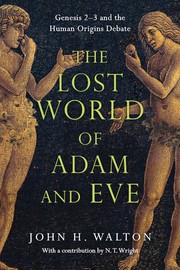Check nearby libraries
Buy this book

For centuries the story of Adam and Eve has resonated richly through the corridors of art, literature and theology. But for most moderns, taking it at face value is incongruous. And even for many thinking Christians today who want to take seriously the authority of Scripture, insisting on a "literal" understanding of Genesis 2-3 looks painfully like a "tear here" strip between faith and science. How can Christians of good faith move forward? Who were the historical Adam and Eve? What if we've been reading Genesis -- and its claims regarding material origins -- wrong? In what cultural context was this couple, this garden, this tree, this serpent portrayed? Following his groundbreaking Lost World of Genesis One, John Walton explores the ancient Near Eastern context of Genesis 2-3, creating space for a faithful reading of Scripture along with full engagement with science for a new way forward in the human origins debate. As a bonus, an illuminating excursus by N. T. Wright places Adam in the implied narrative of Paul's theology. The Lost World of Adam and Eve will be required reading for anyone seeking to understand this foundational text historically and theologically, and wondering how to view it alongside contemporary understandings of human origins. - Publisher.
Check nearby libraries
Buy this book

Previews available in: English
Showing 1 featured edition. View all 1 editions?
| Edition | Availability |
|---|---|
|
1
The Lost World of Adam and Eve: Genesis 2-3 and the human origins debate
2015, IVP Academic, an imprint of InterVarsity Press, IVP Academic
Paperback
in English
0830824618 9780830824618
|
aaaa
Libraries near you:
WorldCat
|
Book Details
Table of Contents
Edition Notes
Classifications
Contributors
The Physical Object
ID Numbers
Community Reviews (0)
Feedback?History
- Created October 22, 2015
- 9 revisions
Wikipedia citation
×CloseCopy and paste this code into your Wikipedia page. Need help?
| March 23, 2024 | Edited by Scott365Bot | Linking back to Internet Archive. |
| May 28, 2023 | Edited by ImportBot | import existing book |
| December 29, 2021 | Edited by ImportBot | import existing book |
| November 13, 2020 | Edited by MARC Bot | import existing book |
| October 22, 2015 | Created by Bryan Tyson | Added new book. |












